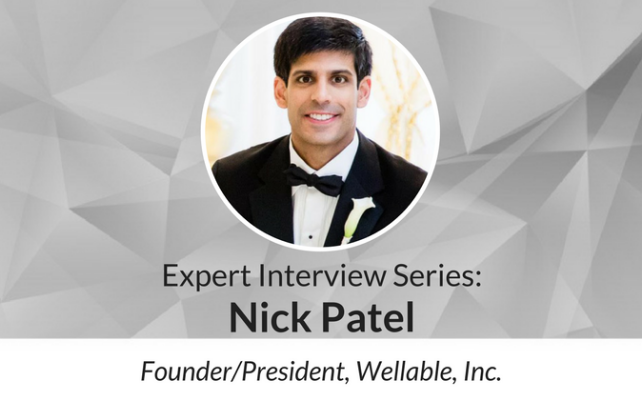Nick Patel is the president of Wellable, where he works tirelessly every day to improve the employee wellness experience all over the world. We recently sat down with Nick to discuss the advantages of employee wellness and how it impacts workplace engagement.
What are some of the innovative ways that Wellable helps improve employee wellness?
Wellable embraces the BYOT (Bring Your Own Technology) movement. We empower employers to launch affordable wellness programs by allowing employees to participate using their own technologies (like a wearable device or smartphone app). This results in higher and more sustainable engagement through personalization and choice as we help employees choose solutions that are best suited for them. At Wellable, we understand that making healthy habits is hard enough, so we try out best to reduce barriers to engagement. We joke that Wellable makes it so easy for both employers and employees that there’s no excuse to not join our programs and live a healthier life!
For employers, we make sure that Wellable is flexible and customizable. Fitness is a one-size-fits-one solution. As such, Wellable encourages participants to use their technology of choice and helps employers develop programs that are unique to their organizational needs and goals. Some companies might focus on increasing engagement and establishing a culture of wellness, and the design of their Wellable program will facilitate that. Others might prefer to tie their efforts to lowering health care costs, and Wellable offers a different set of solutions to these clients.
How often do you detect resistance from employees about using a wearable device to monitor wellness? How do you address their concerns?
It’s less about detection and more about proactive intervention. We do a great job of communicating with employees beforehand about our privacy policy and encourage them to voice their concerns should they see potential problems. We rarely have people opting out of our programs for data privacy reasons. We earned this trust because we made sure that sensitive data is protected, and our assessment surveys are always anonymous. Additionally, the lifestyle-management focus of our programs means that we don’t capture clinical data (CD), such as biometric screening results. CD is much more sensitive and should be a real concern for employees when considering participating in wellness programs.
When it comes to gamification and wellness challenges, to what extent (if any) does the value of the reward or prize correlate with the participation rate?
We view rewards and prizes as valuable ways to invite employees to participate. However, we don’t see these external motivations as the main way to keep participants sustainably engaged. Gift cards or perks only go so far in motivating them to increase their activity or eat healthier. We focus on engaging employees by delivering timely communication, scientific and relevant health content, and fun challenges. So far, these tactics have really paid off. Some of our clients might only offer small rewards, such as $20 gift cards, and still see phenomenal participation and engagement in the program.
Another way to look at it is by thinking of engagement as a pie. Rewards and incentives are certainly a piece of the pie, but so are the social interactions, healthy competition, and personal motivation. By not focusing on any singular aspect, we are able to capture a wider range of participants. Regardless of why people join their program, we give them a reason to participate and thrive.
What is the purpose of providing an onsite health fair for employees?
There are multiple reasons why we encourage our clients to hold health fairs if they have the resources for it. Health fairs are a great place to provide employees with educational resources, as well as to show them opportunities to improve their personal health and well-being. For example, we invite vendors that provide wellness services such as personal trainers, massage therapists, and educators like health coaches to come onsite.
Employers can also have representatives from their health plans setting up booths to provide employees with information about the services and benefits available to them that they might not have been aware of. Because of this, our health fairs can cover a wide breadth of topics on healthy living as well as employer-specific benefit information, such as information on health, vision, and dental plans.
Health fairs have the power to bring employees together for engagement in wellness activities that aren’t normally offered in the workplace (such as pop-up fitness classes or challenges) that will increase camaraderie and promote healthy lifestyles.
If executed properly, health fairs have the potential to engage a significant portion of an employee base, increase awareness on health-related topics and employee benefits, and kick off other initiatives such as a year-round wellness program.
How much of a link is there between employee health and employee engagement?
Similar to drivers of wellness participation, employee engagement is a pie. Employee health is a piece of the pie, but what’s broader than health is employee wellness, which is a more holistic measurement and a larger piece of the pie. Other pieces of the engagement pie are work satisfaction, interpersonal relationships with peers and supervisors, company culture, etc.
We focus our efforts on employee wellness because we know it is such a big piece. By creating exceptional wellness experiences for organizations, we know we are helping companies succeed. That being said, for employees to be truly engaged, the company must satisfy all aspects holistically – which, of course, includes taking care of employees’ health.
What kind of impact do healthy and engaged employees have on company culture and morale – and ultimately, the bottom line?
The relationship between employee well-being, engagement, and company culture is not one-sided; it’s a continuous cycle. Companies with a culture of health guide their employees to embrace healthier habits, offer them wellness services, and make sure that employees know how to take ownership in their health journeys. Aside from the boost in wellness, this act makes employees feel like management cares about them (which is an especially big “brownie point” in the eyes of Millennials), which boosts their satisfaction with the organization and makes them more likely to feel engaged in the work that they do. Improvement of one area continuously feeds into the cycle; each small improvement will multiply and snowball if nurtured correctly.
Also, while indirect, employee engagement does show its impact on the bottom line. According to a Gallup study, highly engaged organizations are twice as likely to succeed than less engaged organizations. Similarly, companies that are in the top quartile have lower absenteeism and turnover, which signals higher worker engagement. In short, an engaged workforce translates to a successful and sustainable business.
What do you predict for the future of employee wellness programs, especially in the areas of wearables and technological advancements?
Even though employee wellness programs still have a lot of room to grow, we see them slowly becoming a must-have. This is similar to how 401Ks used to be nice-to-haves, but now they are a must-have to attract and retain talent.
As wearables become more mainstream, wellness programs will shift their focus from “improving adoption” to “impacting the margin.” Right now, 20% of Americans under age of 65 own fitness trackers, as well as 17% of their older counterparts. In the coming years, the “quantified self” movement will drive this number up to a much higher percentage. In five to ten years when most people already use wearables or wellness apps, wellness programs should no longer focus on getting more people onto the bandwagon. Instead, they should focus on encouraging people to use whatever technology they already own, and then use that data to push them forward just a little bit further or to integrate more of the feedback loops into their everyday lives.
On the wearable side, we see continuous improvement in analytics and usability as well as non-wellness functionalities. For example, Fitbit will focus both on improving the validity of their tracking data and adding functions like payments, voice assistance, etc. to their devices. This will increase a device’s attractiveness and stickiness for a user – attractive because the data will produce more meaningful results, and sticky because more and more of their daily activities will rely on having their devices on their wrists.
Worried that your employees aren’t as engaged as they should be? Contact hubEngage today to see how we can help.













